Abstract
Objectives
To evaluate the influence of the type of osteotomy in the inferior aspect of the mandible on the mechanical performance.
Materials and Methods
The study was performed on 20 polyurethane hemimandibles. A sagittal split ramus osteotomy (SSRO) was designed in 10 hemimandibles (group 1) with a vertical osteotomy in the buccal side (second molar level) and final osteotomy was performed horizontally on the lingual aspect, while the mandible body osteotomy was finalized as a straight osteotomy in the basilar area, perpendicular to the body. For group 2, the same osteotomy technique was used, but an oblique osteotomy was done in the basilar aspect of the mandibular body, forming continuity with the sagittal cut in the basilar area. Using a surgical guide, osteosynthesis was performed with bicortical screws using an inverted L scheme. In both groups vertical compression tests were performed with a linear load of 1 mm/min on the central fossa of the first molar and tests were done with models made from photoelastic resin. Data were analyzed using Student's t-test, establishing a statistical significance when P <0.05.
Results
A statistical difference was not observed in the maximum displacements obtained in the two osteotomies (P <0.05). In the extensiometric analysis, statistically significant differences were identified only in the middle screw of the fixation. The photoelastic resin models showed force dissipation towards the inferior aspect of the mandible in both SSRO models.
The sagittal split ramus osteotomy (SSRO) has been used during the last 50 years in orthognathic surgery1. Since the initial proposal of the SSRO2, there have been modifications for improvement under various biological conditions345. The osteotomy technique suggested by Epker4 was widely accepted, although later other changes were made that emphasized the incorporation of an osteotomy attached in the inferior aspect of the mandible6.
Considering the variety of modifications, there have been relatively few researchers who have studied the effects of the different osteotomy models in relation to their mechanical and functional stability. Indeed, a large proportion of the research has been aimed at studying aspects of the osteosynthesis model used, such as type of plates or bicortical versus mixed screws789, rather than the type of osteotomy.
This lack of research can be explained by the fact that a significant portion of the modifications to the SSRO were in response to isolated cases with anatomical variations, thus making protocolized study difficult in some cases10.
The chances of achieving adequate osteosynthesis in SSRO has been studied elsewhere11 and the impact on surgical rimovements has also been explored789. Therefore, the aim of this investigation was to study the effect of the basilar osteotomy on the mechanical performance of the SSRO with inverted L screw fixation.
Two groups were used in this research. (1) Osteotomy group 1: This group underwent osteotomy as proposed by Epker4, where a horizontal osteotomy was performed on the lingula and then an osteotomy of the anterior sector of the mandibular ramus was performed until reaching the lateral sector of the second molar, whereupon a vertical osteotomy was performed up to the medial sector of the inferior aspect of the mandible.(Fig. 1) (2) Osteotomy group 2: This group underwent the sagittal split osteotomy, which is different from that performed in group 1 in that the surgery incorporated a modification proposed by Wolford and Davis6. In this modification a new osteotomy in the mandibular basilar area was added using a saw specially designed for the purpose and is in an oblique direction on the basilar area.(Fig. 2)
The osteotomies were performed on a polyurethane hemimandible, considered the master model, from which 10 replicas were made for each group in order to make a protocol in all the samples.
Osteosynthesis for the osteotomy, in both groups, was done with three 14 mm bicortical grade V titanium screws of the 2.0 system (Osteosin; Certivet, São Paulo, Brazil) available in inverted L format. Osteosynthesis was done according to a surgical guide constructed especially for this investigation so there would be no variation in the insertion or angulation of the screws. The surgical guide (acrylic device) showed the standardized position of the screws with the point to make the burr insertion and in all samples the same surgical guide was used.
A metallic iron alloy support was constructed, composed of a rectangular base and a vertical horn, giving the mandible rifigidity and stabilization at three points in the posterior sector of the condylar neck, mandibular ramus, and mandibular angle, avoiding the hourly rotation of the system during the load.
For the load test, an EMIC servohydraulic universal testing machine was used, model DL 500 MF (EMIC, Paraná, Brazil). The hemimandible was subjected to a constant linear force of 1 mm/min in the central fossa region of the first molar with the application of a progressive load until the final load (the load at which the system failed) was obtained and displacement of the mandibular system occurred.
The stress measurement was taken through electrical strain gauges (PA-06-060BG-350L, Excel Engenharia de Sensores; Embu, São Paulo, Brazil) positioned directly on the replica of the fixations where each screw used in the osteosynthesis received a sensor to capture the stress and deformation of each screw. Stress was gauged from reading the elastic deformations suffered by the replicas using a computer-assisted machine (ASD0500; Lynx Tecnologia Eletrônica Ltda., São Paulo, Brazil). To capture the electrical signals, the variation caused by alterations in temperature and transduction were calculated and processed by the AqDados 7 software (Lynx Tecnologia Eletrônica Ltda.).(Fig. 3)
For all the samples, a vertical force of up to 3 mm of displacement was applied, considering a force of 1 mm/min. Also studied were the effects on each of the screws, called T1, T2, and T3 from upper to lower.
The statistical analysis was developed with the SPSS version 11.0 software (SPSS Inc., Chicago, IL, USA) using the Student's t-test, assuming a level of statistical significance when P<0.05.
The replica was made in photoelastic resin from the master hemimandible in each group. Each hemimandible was covered by transparent liquid enamel to eliminate surface irregularities. Silicon was installed in each plastic 12×10×5 cm box (Clássicos Artigos Odontológicos Ltda., São Paulo, Brazil) to make the impression of the polyurethane piece. The filling was carried out slowly and kept inside the box for 24 hours. Araldite resin was used in a mixture of GY-279 with catalyzed HY-2963 in the polyurethane hemimandible mold (Adaltec Produtos Químicos Ltda., Guarulhos, Brazil), and held in position for 72 hours as per the manufacturer's instructions.
The screws were installed using the surgical guide, using the inverted L formation. At this stage the 2.0 system was used with 13 mm screws in the same way as was used in the polyurethane mandibles (Osteosin).
The hemimandible (photoelastic resin) was joined by its posterior and upper sector to the universal testing machine for applying compression force (model 4411; Instron, Canton, MA, USA) along with a camera and a flat polariscope (Eikonal Instrumentos Ópticos Comércio e Serviço Ltda., São Paulo, Brazil). The force was applied in the central fossa of the first molar and used in the same way as the aforementioned technique. After application of the compression force, the models that had already been manipulated were transferred to a furnace at 55℃ where they remained for 5 minutes to eliminate residual stresses. The photographic recording was done with a Fuji camera model 9000 (Fuji Corp., Tokyo, Japan) and the test was recorded on a Sony Handycam (DCR-SR300 6.1 MP; Sony Corp., Tokyo, Japan). The stresses caused by the insertion of screws were recorded with this methodology, making it possible to compare the results with the stresses present after the test. The data analysis was descriptive, comparing the location, distribution, and number of fringes observed in the different screws and osteotomy area.
When the two techniques were compared, no statistically significant differences were observed (P=0.243) when the final compression loads were analyzed, and the displacements obtained did not present any significant differences between the techniques either (P=0.092). Analysis of the individual screws revealed that for T1 and T3 there were no significant differences in the resulting stresses (P=0.551 and P=0.245, respectively), whereas for T2 there were significant differences (P<0.05) where the T2 in group 1 endured less stress than did the T2 in group 2.
In the osteotomy samples in group 1, the screws that showed a higher concentration of isochromatic fringes were screws 1 and 3, whereas T2 presented a lower stress level. (Fig. 4) Similarly, for the study of the samples in group 2, screws 1 and 3 presented a greater stress concentration.(Fig. 5) In general terms, the samples in group 2 exhibited less stress than those in group 1 and this finding was confirmed when it was observed that the stress dissipation was lower in group 2.
The modification of any surgical technique must seek to optimize it through better clinical results, simplifying the procedure until the surgical risks are reduced1112. Clinically, the incorporation of the basilar osteotomy into the SSRO may facilitate the intraoperative separation of segments, which would decrease the risk of incorrect fracture6.
The stability of the osteosynthesis in SSRO depends on several factors13; mechanical test have to be isolate of the others variables14. Some investigations studying SSRO with mechanical analysis failed to determine the type of osteotomy, thereby limiting its description15. These studies, therefore, include a variable that is not controlled and thus, the results are not totally comparable.
The mechanical and photoelastic model has been utilized by other researchers916, who described and qualified photoelasticity as a means of analysis that enables the joint visualization of stress in bodies being analyzed, which is very useful in the analysis of complex anatomical regions such as the mandibular bone. The selected point for applied force (the first molar) has been used in other research by Sato et al.8, and for improved comparison the first molar was the point selected in the current study. Vertical compression is a single force direction and is dramatically different from the forces in the masticatory function, which are multi directional. However, to perform an analysis of the mechanical behavior, a single force direction can be used to isolate the variables involved in this complex analysis.
An important complement to the results of the photoelasticity test lies in the management of combined extensiometry. When forces are applied to stationary objects it is possible to observe stress (internal resistance of the object to the movement) and later deformation (displacement generated by the stress)17. The extensometer converts the mechanical movement into electrical signals, which are converted into units of force by certain software programs.
In this study, the decision to use bicortical screws in the osteosynthesis was due to their better mechanical performance over miniplates or other systems, as reported in other research 8181920. This situation allows the variable osteotomy to be isolated with greater clarity and the main places of force distribution to be identified. However, the miniplate fixation has been related to adequate performance for the control of postoperative complications, temporomandibular joint (TMJ) dysfunction, and osteotomy stability21. Monocortical screws and miniplates show minor compression in the gap of the osteotomy, and these conditions could be associated with better condylar repositioning in the postoperative period22, showing only minor complications related to TMJ distortion and occlusal settling.
The results of this research showed that screw number 2, in the middle of the inverted L, was where the greatest stress was observed in group 1, demonstrating that this is the area of greatest strain on the system. In group 2 (with basilar osteotomy), no differences were observed, showing that the strain on each screw was equal. The different osteotomy designs can cause changes in the center of gravity and fulcrum for rotation, which might explain the different results regarding the stress on the screws and the differences in the mechanical behavior.
The study by Sato et al.9 showed that by means of finite analysis and using the osteotomy proposed by Epker4 (similar to the surgery for group 1 in our study), stress in the proximal segment essentially dissipated in areas of greater bone structure, preferably the external oblique line. The main stress was observed in the upper screw, followed by the middle and the lower, although the stress dissipation went downwards.
With the photoelastic model, our results showed a high formation of fringes between screws 2 and 3, leaving the highest screw with less fringe distribution. The decrease in fringe distribution on the highest screw indicates that there was less stress on this screw, which is different from the results of other research9. Another study by Sato et al.8 performed on a photoelastic model (with the same type of osteotomy) showed that the stress distribution among the screws was very similar, in contrast to the finite analysis model. This variation among results may be explained by differences between the values and records entered in the software that processes the finite analysis model.
Our results confirm that the area of greatest stress was in the oblique line of the mandible, which is consistent with the findings of other authors23. Through the SSRO and inverted L screw fixation, the stress distribution transfers to the closest area, which is the inferior and basilar region. This distribution of stress may cause clinical complications because the osteotomy itself causes an area of greater fragility towards the inferior aspect of the mandible due to the decrease in bone width24, but this condition could be controlled by means of a basilar osteotomy of the mandible6.
In terms of clinical implications, the basilar osteotomy was proposed for use clinically because it could diminish the stress on the basilar area and avoid the bad split resulting from the sagittal osteotomy6, which requires the use of a modified saw. However, our results show that no differences were observed in the stress distributions in the basilar area between the two techniques. The basilar osteotomy, with or without degree, shows the same behavior. The screw position could be affected by the vertical load but without statistical significance; qualitatively, the load distribution was different, but showed no quantitative differences.
References
1. Obwegeser HL. Orthognathic surgery and a tale of how three procedures came to be: a letter to the next generations of surgeons. Clin Plast Surg. 2007; 34:331–355. PMID: 17692696.

2. Trauner R, Obwegeser H. The surgical correction of mandibular prognathism and retrognathia with consideration of genioplasty. I. Surgical procedures to correct mandibular prognathism and reshaping of the chin. Oral Surg Oral Med Oral Pathol. 1957; 10:677–689. PMID: 13441284.
3. Dal Pont G. Retromolar osteotomy for the correction of prognathism. J Oral Surg Anesth Hosp Dent Serv. 1961; 19:42–47. PMID: 13719390.
4. Epker BN. Modifications in the sagittal osteotomy of the mandible. J Oral Surg. 1977; 35:157–159. PMID: 264514.
5. Ellis E 3rd. A method to passively align the sagittal ramus osteotomy segments. J Oral Maxillofac Surg. 2007; 65:2125–2130. PMID: 17884553.

6. Wolford LM, Davis WM Jr. The mandibular inferior border split: a modification in the sagittal split osteotomy. J Oral Maxillofac Surg. 1990; 48:92–94. PMID: 2294218.

7. Brasileiro BF, Grempel RG, Ambrosano GM, Passeri LA. An in vitro evaluation of rigid internal fixation techniques for sagittal split ramus osteotomies: advancement surgery. J Oral Maxillofac Surg. 2009; 67:809–817. PMID: 19304039.

8. Sato FR, Asprino L, Consani S, Noritomi PY, de Moraes M. A comparative evaluation of the hybrid technique for fixation of the sagittal split ramus osteotomy in mandibular advancement by mechanical, photoelastic, and finite element analysis. Oral Surg Oral Med Oral Pathol Oral Radiol. 2012; 114(5 Suppl):S60–S68. PMID: 23083958.

9. Sato FR, Asprino L, Noritomi PY, da Silva JV, de Moraes M. Comparison of five different fixation techniques of sagittal split ramus osteotomy using three-dimensional finite elements analysis. Int J Oral Maxillofac Surg. 2012; 41:934–941. PMID: 22510341.

10. Wyatt WM. Sagittal ramus split osteotomy: literature review and suggested modification of technique. Br J Oral Maxillofac Surg. 1997; 35:137–141. PMID: 9146874.

11. Vinicius de Oliveira M, de Moraes PH, Olate S, Alonso MB, Watanabe PC, Haiter-Neto F, et al. Morphometric study of mandibular ramus related to sagittal ramus split osteotomy and osteosynthesis. J Craniofac Surg. 2012; 23:1484–1487. PMID: 22976641.

12. Gallia L. Modification of the sagittal ramus osteotomy to produce a more accurate inferior border split. J Oral Maxillofac Surg. 1992; 50:1136–1137. PMID: 1527673.

13. Ochs MW. Bicortical screw stabilization of sagittal split osteotomies. J Oral Maxillofac Surg. 2003; 61:1477–1484. PMID: 14663815.

14. Haug RH, Serafin BL. Mandibular angle fractures: a clinical and biomechanical comparison--the works of Ellis and Haug. Craniomaxillofac Trauma Reconstr. 2008; 1:31–38. PMID: 22110787.

15. Chuong CJ, Borotikar B, Schwartz-Dabney C, Sinn DP. Mechanical characteristics of the mandible after bilateral sagittal split ramus osteotomy: comparing 2 different fixation techniques. J Oral Maxillofac Surg. 2005; 63:68–76. PMID: 15635560.

16. Kim HC, Essaki S, Kameyama T, Yamamoto K. Photoelastic analysis of internal screw fixation after sagittal split ramus osteotomy. J Craniomaxillofac Surg. 1993; 21:266–270. PMID: 8227377.

17. Grellmann W, Berghaus A, Haberland EJ, Jamali Y, Holweg K, Reincke K, et al. Determination of strength and deformation behavior of human cartilage for the definition of significant parameters. J Biomed Mater Res A. 2006; 78:168–174. PMID: 16628548.

18. Anucul B, Waite PD, Lemons JE. In vitro strength analysis of sagittal split osteotomy fixation: noncompression monocortical plates versus bicortical position screws. J Oral Maxillofac Surg. 1992; 50:1295–1299. PMID: 1447609.

19. Hammer B, Ettlin D, Rahn B, Prein J. Stabilization of the short sagittal split osteotomy: in vitro testing of different plate and screw configurations. J Craniomaxillofac Surg. 1995; 23:321–324. PMID: 8530709.

20. Peterson GP, Haug RH, Van Sickels J. A biomechanical evaluation of bilateral sagittal ramus osteotomy fixation techniques. J Oral Maxillofac Surg. 2005; 63:1317–1324. PMID: 16122596.

21. Borstlap WA, Stoelinga PJ, Hoppenreijs TJ, van't Hof MA. Stabilisation of sagittal split advancement osteotomies with miniplates: a prospective, multicentre study with two-year follow-up. Part I. Clinical parameters. Int J Oral Maxillofac Surg. 2004; 33:433–441. PMID: 15183405.
22. Sato FR, Asprino L, Fernandes Moreira RW, de Moraes M. Comparison of postoperative stability of three rigid internal fixation techniques after sagittal split ramus osteotomy for mandibular advancement. J Craniomaxillofac Surg. 2014; 42:e224–e229. PMID: 24103461.

23. Champy M, Lodde JP. Mandibular synthesis. Placement of the synthesis as a function of mandibular stress. Rev Stomatol Chir Maxillofac. 1976; 77:971–976. PMID: 1071237.
24. Obeid G, Lindquist CC. Optimal placement of bicortical screws in sagittal split-ramus osteotomy of mandible. Oral Surg Oral Med Oral Pathol. 1991; 71:665–669. PMID: 2062519.





 PDF
PDF ePub
ePub Citation
Citation Print
Print


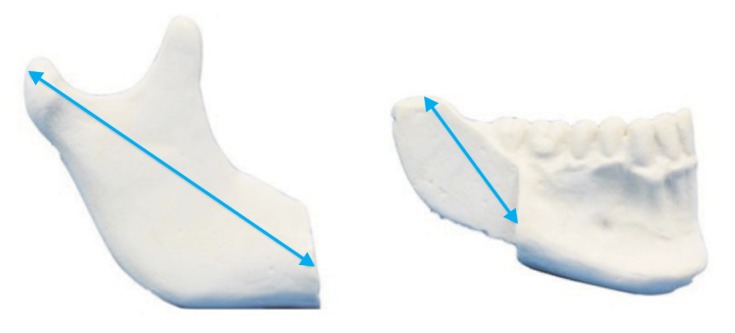
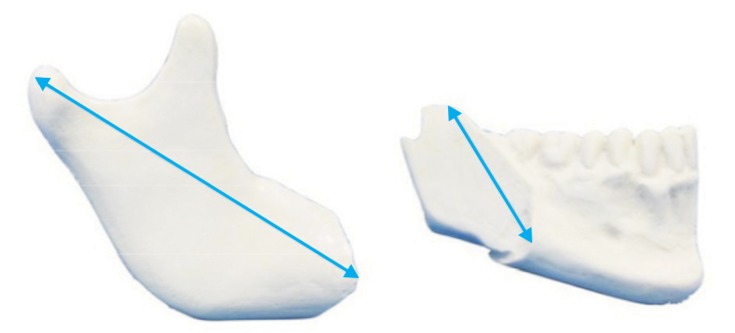
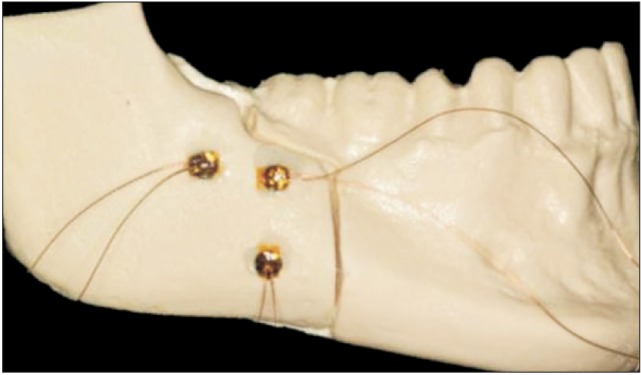
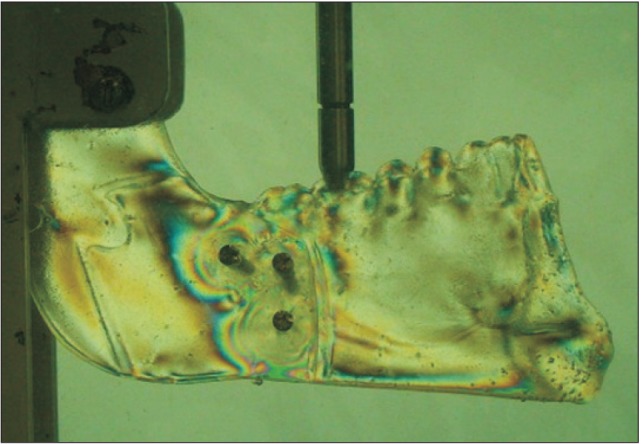
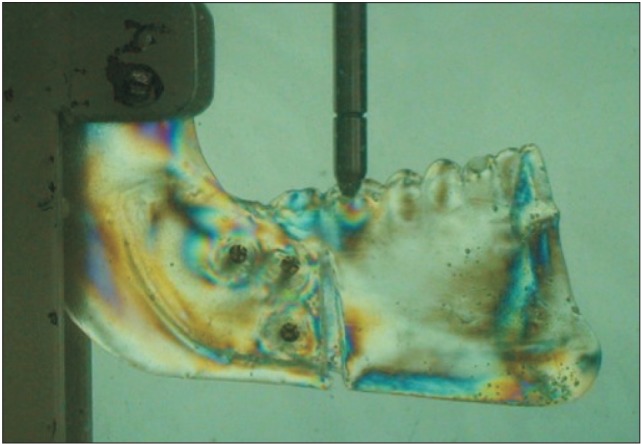
 XML Download
XML Download